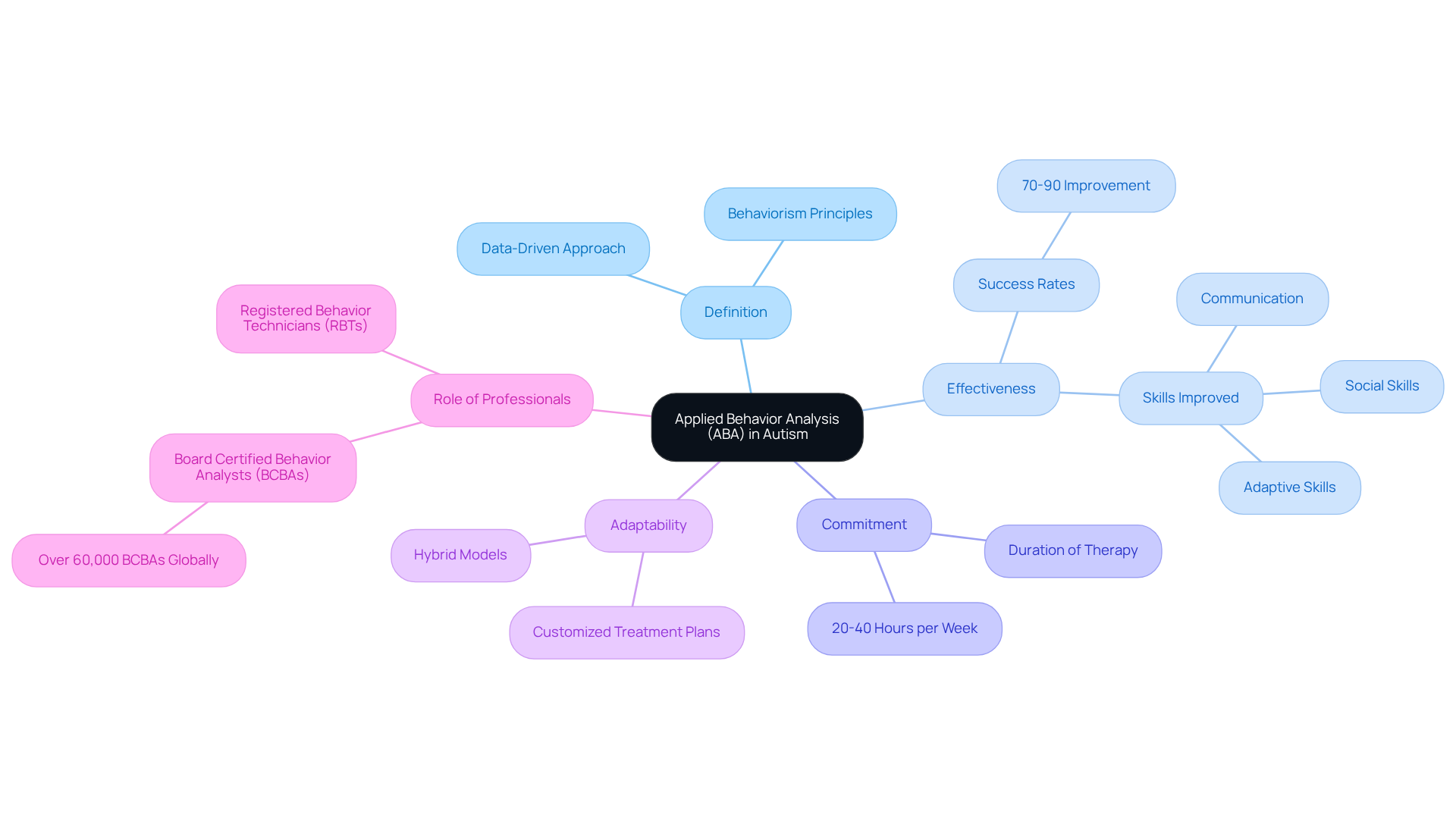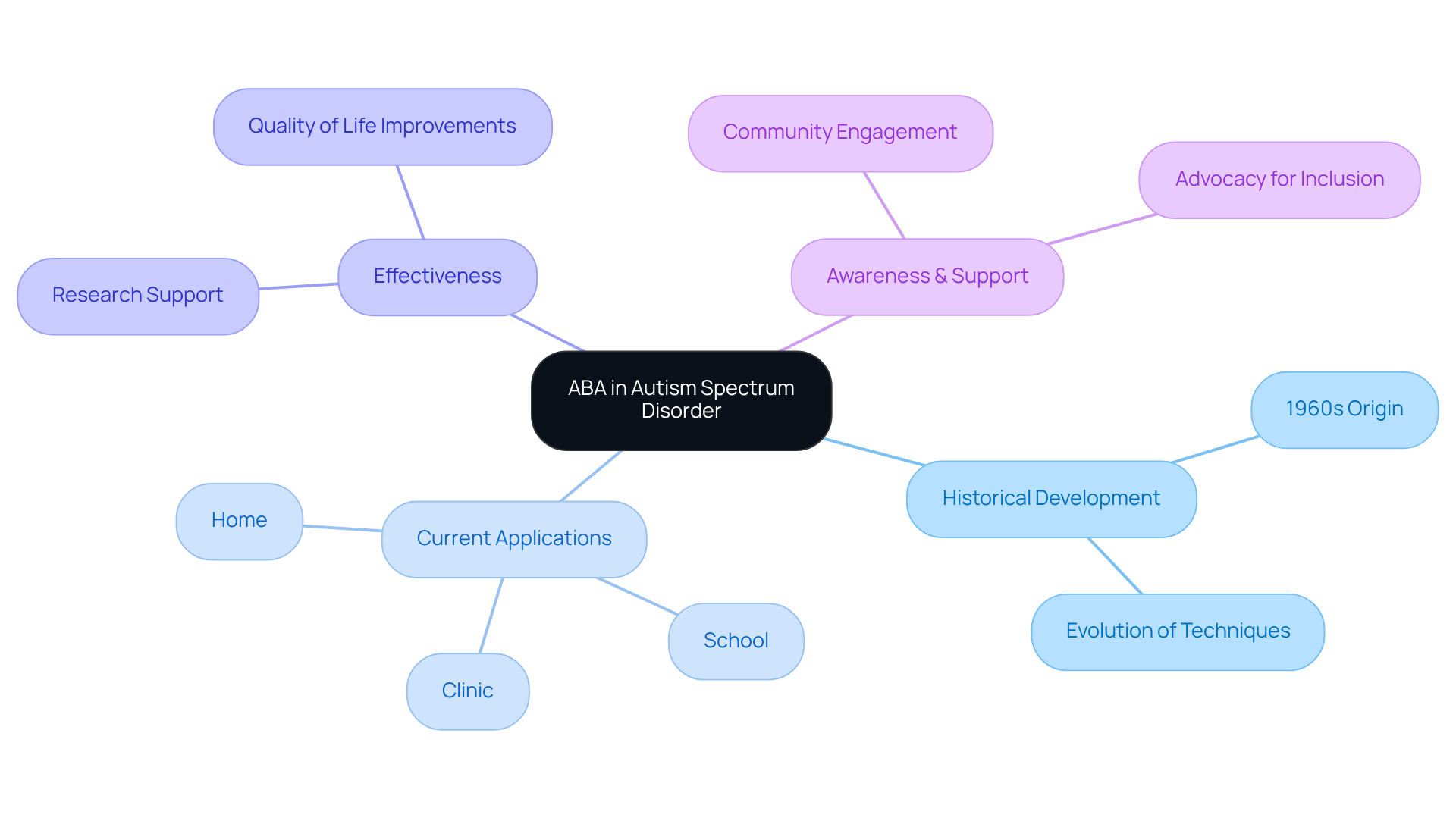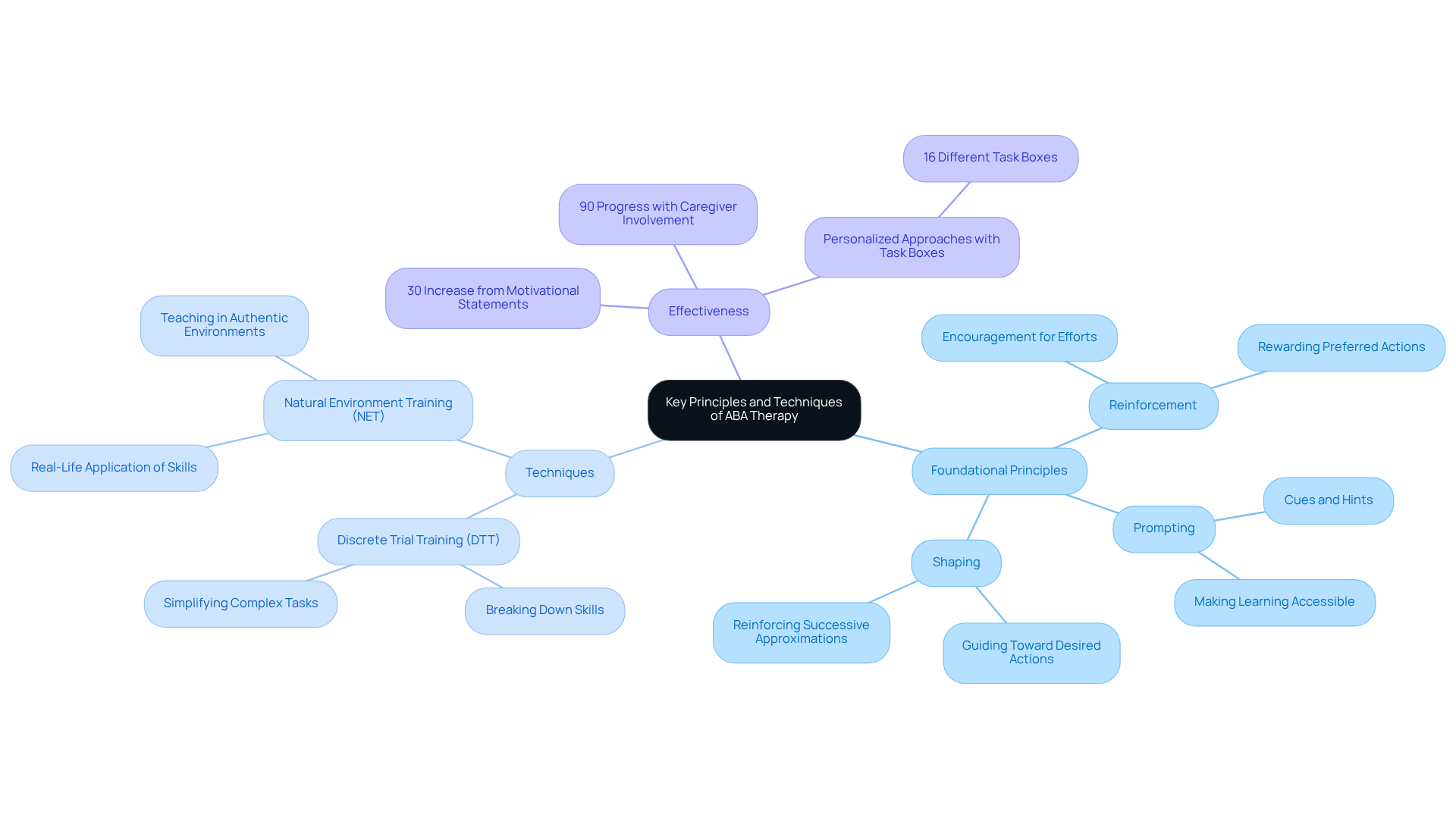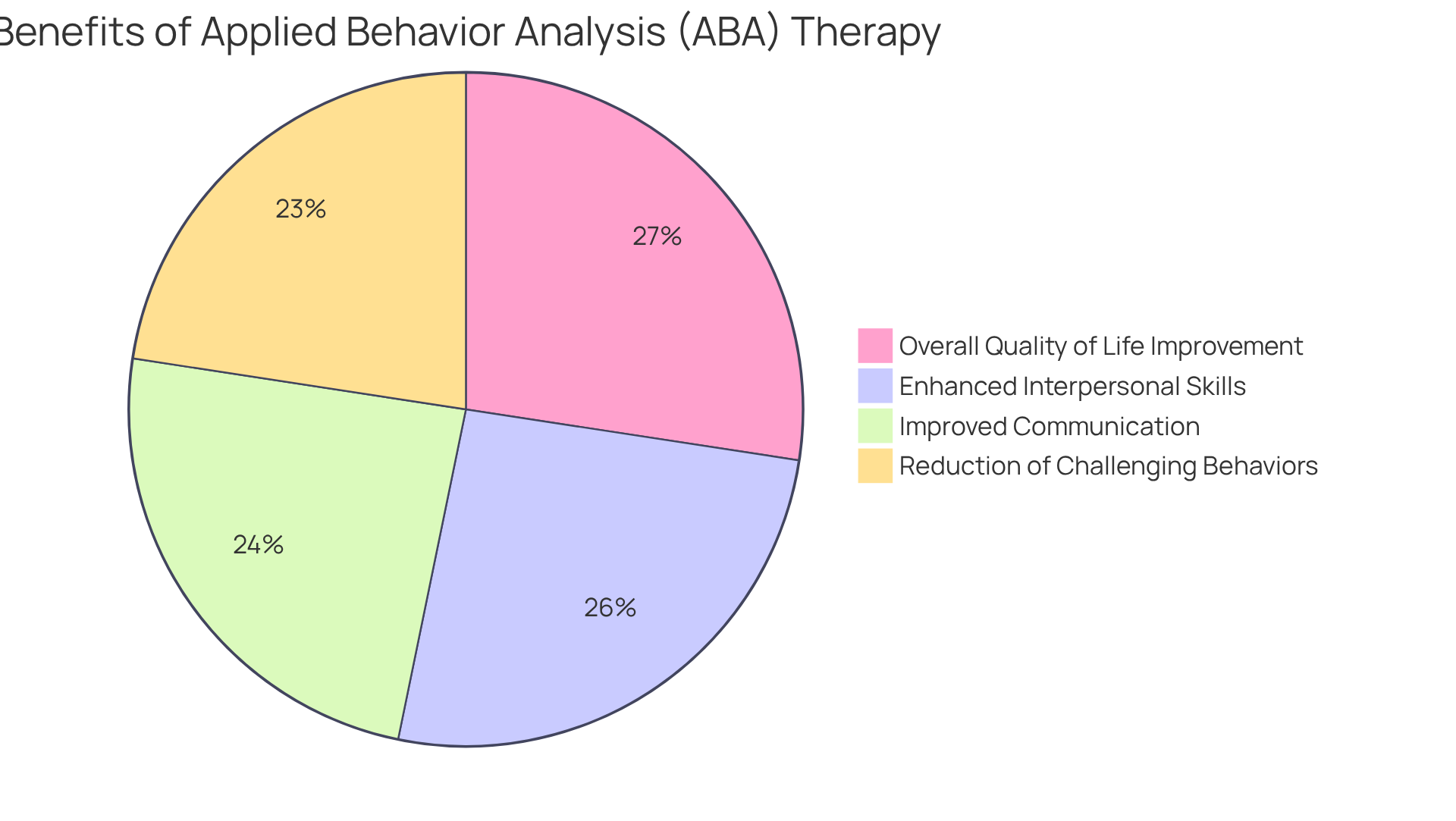Overview
Applied Behavior Analysis (ABA) autism represents a compassionate, structured approach designed to enhance communication and social skills while reducing challenging behaviors in individuals with autism. Research supports the effectiveness of ABA, highlighting significant progress in skills, especially when tailored interventions are applied during early childhood. This makes ABA an invaluable resource for families eager to support their child's development.
As parents, you may find yourselves searching for effective strategies to nurture your child's growth. ABA not only provides a framework for improvement but also fosters a deeper understanding of your child's unique needs. Imagine witnessing your child communicate more effectively or engage in social interactions with newfound confidence. These are the possibilities that ABA can unlock.
We encourage you to explore ABA further, as it can be a beacon of hope in your journey. By seeking tailored interventions, you can pave the way for your child's brighter future. Remember, you are not alone in this journey; support is available, and together, we can make a difference.
Introduction
Applied Behavior Analysis (ABA) has emerged as a crucial approach in understanding and addressing the complexities of Autism Spectrum Disorder (ASD). This method focuses on enhancing communication, social skills, and learning while minimizing challenging behaviors. By offering a structured, data-driven approach, ABA has shown remarkable success, especially when initiated early in a child's development.
Yet, as parents, you may wonder about the adaptability of ABA techniques. How can these methods be tailored to meet the unique needs of your child on the spectrum? Understanding the core principles that make ABA so impactful can help us leverage this knowledge to foster a brighter future for those with autism.
Let’s explore how ABA can be a beacon of hope and support for families navigating the challenges of ASD. Together, we can uncover the potential that lies within each child and create a nurturing environment for growth and development.
Define Applied Behavior Analysis (ABA) in Autism
Applied Behavior Analysis (ABA) is a compassionate, data-driven method designed to understand and positively change behaviors, particularly in individuals, which brings us to what is ABA autism. This approach focuses on enhancing vital skills such as communication, interpersonal relationships, and learning, all while effectively reducing challenging behaviors. Grounded in the principles of behaviorism, ABA is based on the belief that behaviors can be learned or unlearned through reinforcement and consequences.
Research shows that early intervention, especially between the ages of 2 and 6, can lead to remarkable improvements in communication and social skills, with success rates ranging from 70% to 90% for children who engage in intensive ABA therapy. Typically, ABA treatment involves a commitment of 20-40 hours each week over several months or even years, tailored to meet individual needs. For instance, children enrolled in structured ABA programs often demonstrate significant progress in interacting with peers and navigating social situations.
What makes ABA therapy particularly effective is its adaptability; it can be customized to address the unique needs of each child, ensuring a personalized approach that resonates with families. As research continues to affirm its effectiveness, understanding what is ABA autism serves as a fundamental resource in fostering essential life skills for those on the autism spectrum. Furthermore, the growing number of Board Certified Behavior Analysts (BCBAs) worldwide provides reassurance to parents, ensuring access to qualified professionals who can offer support and guidance.

Contextualize ABA within Autism Spectrum Disorder
Autism Spectrum Disorder (ASD) encompasses a diverse range of developmental conditions that present challenges in social interaction, communication, and repetitive behaviors. During the 2015-2019 period, the prevalence of ASD rose to approximately 0.99%, underscoring the urgent need for effective interventions. One such intervention, Applied Behavior Analysis (ABA), is often referenced when discussing what is ABA autism, and it emerged as a key approach in the mid-20th century, recognized for its structured method of modifying behaviors.
Initially developed in the 1960s, ABA has undergone significant evolution, adapting to meet the unique needs of individuals with autism. Today, it is implemented in various settings, including homes, schools, and clinics, supported by a robust body of research that highlights its effectiveness in enhancing the quality of life for those on the spectrum. Recent advancements in ABA techniques, such as the integration of visual supports and contingency maps, further enhance its application, solidifying its role as a cornerstone of autism treatment.
The growing demand for certified ABA therapists reflects a heightened recognition of ABA's importance in autism care. Understanding what is ABA autism, along with its historical development and ongoing evolution, allows us to appreciate its vital role in addressing the complexities of autism. As Temple Grandin aptly stated, 'I am different, not less,' a sentiment that beautifully emphasizes the unique perspectives of individuals on the spectrum. By fostering awareness and support, we can create a more inclusive environment for everyone.

Explore Key Principles and Techniques of ABA Therapy
To understand what is aba autism, one must recognize that the foundational principles of Applied Behavior Analysis (ABA) therapy encompass reinforcement, prompting, and shaping, each playing a vital role in supporting your child's development.
- Reinforcement, for instance, involves rewarding preferred actions, effectively increasing the likelihood of those actions being repeated. Imagine the joy of seeing your child thrive as they receive encouragement for their efforts!
- Prompting, on the other hand, offers cues or hints that assist individuals in performing specific actions, making learning more accessible and engaging.
- Shaping is a gradual yet rewarding process where your child is guided toward a desired action by reinforcing successive approximations, allowing for incremental progress that builds confidence.
Among the techniques used in ABA treatment, Discrete Trial Training (DTT) and Natural Environment Training (NET) stand out for their unique approaches.
- DTT breaks down skills into small, manageable steps, simplifying the learning of complex tasks.
- In contrast, NET focuses on teaching skills in authentic environments, encouraging the application of what your child learns to real-life situations.
Research shows that when suggested hours of intervention related to what is ABA autism are fully enacted with active caregiver involvement, an impressive 90% of individuals demonstrate significant progress. This highlights what is ABA autism in terms of its effectiveness in fostering growth and development.
Furthermore, the strategic application of reinforcement and prompting techniques is backed by insights from behavior analysts.
- For example, motivational statements can lead to a remarkable 30% increase in positive behavioral outcomes. This underscores the importance of creating a supportive and encouraging atmosphere during treatment.
- By combining these principles and techniques, such as using 16 different task boxes for teaching specific interpersonal skills, ABA interventions can be tailored to address your child's unique needs. This personalized approach promotes significant growth and development, paving the way for a brighter future.

Highlight Benefits and Outcomes of ABA Therapy
The benefits of Applied Behavior Analysis (ABA) treatment, which answers what is aba autism, are not just theoretical; they are extensively backed by research that highlights significant improvements in communication, interpersonal skills, and adaptive actions among children with autism. Imagine watching your child engage more with peers and excel academically—this is a reality for many involved in ABA treatment. Techniques such as behavioral modeling, prompting, and discrete trial training are at the heart of ABA, offering structured methodologies that truly facilitate learning.
Moreover, ABA intervention plays a crucial role in reducing challenging behaviors like tantrums and aggression, fostering a more harmonious environment both at home and in school settings. The organized system of ABA, which includes the use of task boxes for teaching interpersonal skills, empowers parents with effective strategies to support their child's growth. This collaborative learning environment is essential for nurturing development.
Early intervention is key, as it significantly enhances developmental outcomes. Ultimately, the results of ABA treatment can greatly improve the quality of life for both children and their families. Research indicates that between 63% and 88% of participants report advancements in their interpersonal skills. This statistic underscores the transformative potential of ABA therapy in fostering communication and social competence, while also embracing the broader context of neurodiversity and acceptance. If you are considering options for your child, we encourage you to explore what is aba autism and its profound benefits.

Conclusion
Applied Behavior Analysis (ABA) is an invaluable resource for understanding and meeting the needs of individuals on the autism spectrum. This compassionate, data-driven approach highlights the significance of personalized interventions that not only enhance communication, social skills, and learning but also effectively manage challenging behaviors. By focusing on principles like reinforcement, prompting, and shaping, ABA therapy nurtures essential life skills and empowers families to support their children’s growth.
In this article, we have explored key insights into the historical context, principles, and techniques of ABA. The evolution of ABA, from its mid-20th century origins to its current applications across various environments, showcases its adaptability and effectiveness. Research consistently shows that early intervention through ABA can lead to remarkable improvements in social interaction and communication, with success rates reaching up to 90% for children involved in intensive therapy. Structured methodologies, such as Discrete Trial Training and Natural Environment Training, further underscore the potential for transformative outcomes.
The significance of ABA goes beyond immediate behavioral changes; it opens the door to an enhanced quality of life for children with autism and their families. By fostering a supportive and inclusive environment, ABA principles can help bridge the gap between neurodiverse individuals and their communities. As awareness and understanding of ABA continue to grow, it is crucial for parents and caregivers to explore its benefits and consider its application in their children’s lives. Embracing the message of neurodiversity and the potential for growth through tailored interventions can illuminate the path toward a brighter future for those on the autism spectrum.
Frequently Asked Questions
What is Applied Behavior Analysis (ABA) in the context of autism?
Applied Behavior Analysis (ABA) is a compassionate, data-driven method aimed at understanding and positively changing behaviors in individuals, particularly those with autism. It focuses on enhancing skills like communication, interpersonal relationships, and learning while reducing challenging behaviors.
How effective is ABA therapy for children with autism?
Research indicates that early intervention with ABA therapy, particularly between the ages of 2 and 6, can lead to significant improvements in communication and social skills, with success rates ranging from 70% to 90% for children who participate in intensive ABA therapy.
What does ABA therapy typically involve in terms of time commitment?
ABA therapy generally requires a commitment of 20-40 hours per week over several months or even years, with programs tailored to meet the individual needs of each child.
What are some benefits of structured ABA programs for children?
Children enrolled in structured ABA programs often show significant progress in their ability to interact with peers and navigate social situations, enhancing their overall social skills.
Why is the adaptability of ABA therapy important?
The adaptability of ABA therapy is crucial because it allows the approach to be customized to address the unique needs of each child, ensuring a personalized experience that resonates with families.
What is the role of Board Certified Behavior Analysts (BCBAs) in ABA therapy?
Board Certified Behavior Analysts (BCBAs) are qualified professionals who provide support and guidance in ABA therapy, reassuring parents about the quality of care their children receive as the number of BCBAs continues to grow worldwide.




